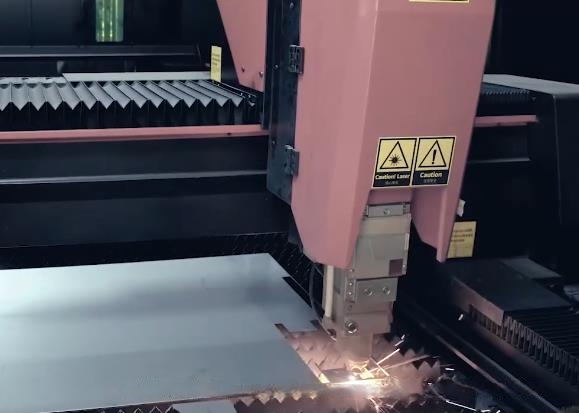Laser cutting faces several challenges primarily related to material properties, heat management, and equipment maintenance.
Challenges and Solutions of Laser Cutting
1. Difficulty in Cutting Highly Reflective Materials
Problem: Materials such as copper, brass, and aluminum alloys reflect much of the laser energy instead of absorbing it for cutting.
Consequences: Not only does this prevent cutting, but the reflected laser can damage optical components (e.g., focusing lenses, nozzles), even burning the laser head itself. This leads to high maintenance costs.
Solution: Special fiber lasers (e.g., green or pulsed fiber lasers) and adjustments to process parameters (e.g., high-pressure nitrogen cutting) are required, but this increases both costs and complexity.
2. Limited Cutting Ability and Low Efficiency for Thick Plates
Problem: The thicker the material, the higher the required laser power and slower the cutting speed to ensure complete penetration.
Consequences:
- Reduced Cut Quality: Rough edges, slag, and tapering (wider top, narrower bottom) are common.
- Increased Costs: High energy consumption and significant auxiliary gas usage make cutting thick plates uneconomical.
For materials thicker than 25mm, laser cutting’s efficiency and cost-effectiveness are often inferior to plasma cutting.
3. High Operational and Maintenance Requirements
Laser optical paths require precise calibration. Optical lenses (e.g., protective and focusing lenses) are fragile and can easily be contaminated by fumes or scratched.
Even slight misalignment or contamination leads to a sharp decline in cutting efficiency and can prevent full penetration. This requires skilled operators and regular maintenance.
4. High Initial Investment Cost
High-power laser cutting machines are expensive, making them the most costly equipment among the three cutting technologies.
Workaround and Alternative Methods for Cutting Highly Reflective Materials
While solving the issue of cutting highly reflective materials without using special wavelength lasers or adjusting laser parameters (e.g., pulsed mode) is challenging due to the inherent reflective properties of the materials, there are "workaround" methods in practice. These methods shift from "preventing reflection" to "utilizing or circumventing reflection," but each comes with significant compromises.
Possible Alternatives and Their Pros and Cons
1. Surface Treatment Method (Most Common, Effective)
Method: Treat the material surface before cutting to reduce its reflectivity.
Process: Apply laser-specific darkening coatings, markers, non-reflective adhesives, or simple phosphoric acid or oxidants to form a dark, light-absorbing layer on the cutting path.
Advantages:
- Simple and low cost, immediate results.
- Significantly improves laser absorption, stabilizing the cutting process and protecting the laser head.
Disadvantages:
- Adds a preprocessing step, reducing overall production efficiency.
- Post-cut cleaning may be required, adding additional costs.
- Can damage or contaminate the pristine surface of high-quality parts.
2. Focus Adjustment Method
Method: Set the laser focus just below the surface (negative defocus), which creates a larger spot and lowers energy density at the material surface.
Advantages:
- Lower energy density reduces reflection.
- Once the surface starts melting and vaporizing, the material's absorption rate increases, allowing for continued cutting.
Disadvantages:
- Cut quality decreases: wider kerfs, rougher surfaces.
- Slower cutting speeds reduce efficiency.
- Essentially a "compromise on quality for feasibility" approach with unreliable results.
3. Auxiliary Material Method
Method: Begin cutting from an existing hole, edge, or waste piece (e.g., a metal scrap), which helps absorb the laser energy.
Advantages:
- No need for full surface treatment, targeted approach.
Disadvantages:
- Limited flexibility in programming and nesting; cuts must start from specific points or edges.
- Labor-intensive, not suitable for complex shapes or mass production.
- Unstable success rate.
4. High-Pressure Nitrogen Cutting (For Thin Sheets)
Method: Use extremely high-pressure nitrogen (up to 30 bar or more) as an assist gas.
Advantages:
- If successful, cut quality is high (no oxidation).
Disadvantages:
- High nitrogen consumption, leading to high costs.
- Effective only for very thin, highly reflective materials (e.g., thin copper or aluminum foils), not suitable for thicker plates.
- Puts significant strain on equipment’s gas system and nozzles.
Key Conclusion and Strong Recommendations
All the methods discussed above are "workarounds," not "solutions." They have inefficiencies, unreliable quality, or additional costs. The best solution remains to use specialized lasers:
- For copper: Green fiber lasers (532nm wavelength) or pulsed fiber lasers are the industrial standard. Copper absorbs up to 40% of green light, which is much higher than the less than 5% absorption at 1064nm.
- For aluminum: High-power fiber lasers (>6000W) with advanced pulsed control can cut thin aluminum (e.g., <6mm) with relatively stable results, though green lasers are still the better choice for thick aluminum or precision cutting.
Temporary process methods are suitable for occasional, small-batch production with less stringent quality requirements. Any method attempted must include careful monitoring of the cutting process and installation of high-quality anti-reflection protection to avoid damaging the laser and incurring huge economic losses.
If you require laser cutting services, Rapid Model is happy to assist you. Upload your product drawings, and our engineers will devise a cutting plan tailored to your product.



